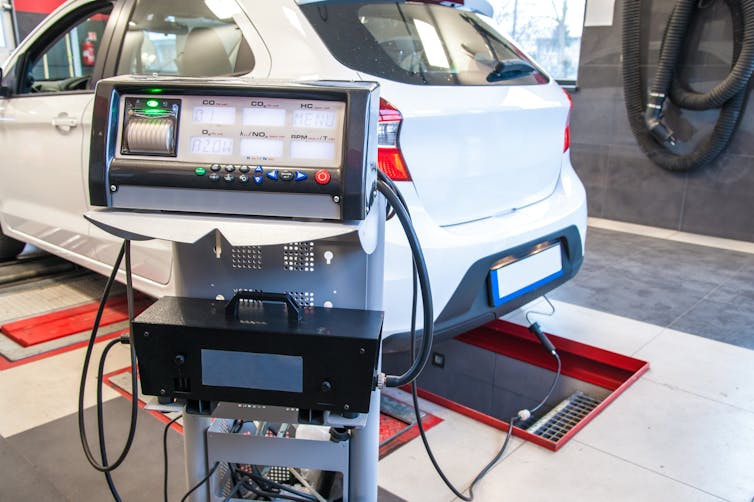Currently accounting for 3% of new car sales, plug-in hybrid electric vehicles are sold as low-carbon alternatives to fossil fuel and conventional hybrid cars. But a new report threatens to shatter their green credentials.
Research from the pressure groups Transport and Environment and Greenpeace has claimed that CO₂ emissions from plug-in hybrid cars are “two and a half times” higher than tests by manufacturers suggest. While these official figures place the average emissions from plug-in hybrid vehicles at 44g of CO₂ per kilometer, the new report argues that it’s more like 120g on roads.
So why is there such a large discrepancy, and which one is correct? Are customers being misled about the environmental impact of the cars they drive?
How carmakers measure emissions
A plug-in hybrid electric vehicle has both a petrol engine and battery, either of which can power the wheels. Unlike a normal hybrid vehicle, where all the energy comes from the fuel, a plug-in hybrid has a larger battery and can be plugged into the mains to charge. Because a plug-in hybrid has two energy sources, petrol and electric, its emissions will vary widely depending on how much time is spent in full electric or petrol mode.
To find out how far a plug-in hybrid car can travel without switching the engine on (known as “the all-electric range”), car manufacturers in the UK and EU use a test called the Worldwide harmonized Light-duty vehicles Test Procedure (WLTP). For a plug-in hybrid car, the battery is fully charged and then driven on a repeated 30-minute cycle under controlled conditions on a dynamometer, which is a bit like a treadmill for cars.
During each cycle, the battery is slowly discharged as the car uses energy from both the battery and the engine. Eventually it reaches a point when the battery charge at the beginning and end of each 30-minute cycle is the same. This is referred to as charge-sustain mode and is the point at which all the energy comes from the petrol engine and the battery is essentially empty. Manufacturers calculate their official emissions figures based partly on emissions during the time when the car is using petrol and electricity, and partly when the car is running on petrol only.

While the official test considers both petrol and electric energy sources, it assumes the battery starts fully charged and ends the test almost empty and running on the fossil fuel engine. If the actual distance driven is less than the official test, then the car will spend more time using both the fuel and electricity, and the emissions will be lower than the official value, possibly zero if it is within the all-electric range where the engine does not switch on. Likewise, if the vehicle travels further, or the battery is not charged at the start, then the emissions will be higher than the official value. This is all before we consider the difference between emissions measured during official tests and real-world driving.
The recent report used real-world data from a range of sources across Europe, with directly measured emissions and data reported from drivers themselves. It also included some data that predated the 2017 change to the WLTP legislation that was intended to reduce the discrepancy between laboratory and real-world emissions data. In fact, the official value of 44g of CO₂ per kilometer is actually from an older type of test, and is lower than you would expect to get with the new test, which typically gives higher CO₂ emissions.
In the real world
So, what are the real emissions of plug-in hybrid cars? Well, technically both the manufacturer’s value and those in the new report are correct. This really highlights the issue of using a single figure to define emissions for these vehicles.
If you have a short commute operating mainly in electric mode and charge your vehicle regularly, then you will likely have emissions lower than the average manufacturer’s value of 44g of CO₂ per kilometer. If you often make long journeys and never plug the vehicle into the mains, your emissions will be comparable or worse than a non-hybrid vehicle, as the recent report highlighted.
Personally, I would like to see manufacturers report emissions during the petrol only driving mode alongside the current measurement and all-electric range. This would show customers how the car performs if the battery is not charged and provide an incentive to plug in more frequently. This data is already collected as part of the current official test procedure, so it wouldn’t require any retrospective testing.
Used properly, plug-in hybrid electric vehicles can be a great choice for people who want to reduce their emissions but are not ready or able to let go of the convenience of petrol and diesel vehicles. Before buying one though, you should consider if a full battery electric vehicle might be a better choice. The typical range of electric vehicles now regularly exceeds 200 miles, their costs are comparable to plug-in hybrids and charging infrastructure and charging speeds are continuously improving.![]()
This article is republished from The Conversation by Ashley Fly, Lecturer in Vehicle Electrification, Loughborough University under a Creative Commons license. Read the original article.
SHIFT is brought to you by Polestar. It’s time to accelerate the shift to sustainable mobility. That is why Polestar combines electric driving with cutting-edge design and thrilling performance. Find out how.
Get the TNW newsletter
Get the most important tech news in your inbox each week.







